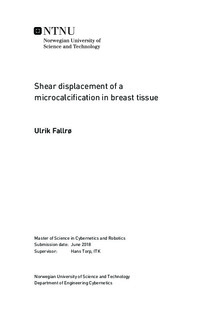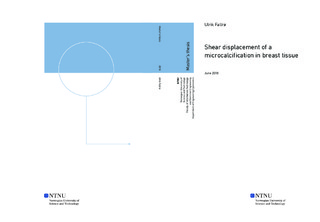| dc.description.abstract | Breast cancer is the second largest cause of cancer death for women. Irregular patterns of microcalcifications in the breast may indicate a malignant cancer tumor, which is used as an important indicator in the diagnosis of breast cancer. X-ray mammography is currently the standard for early detection and diagnosis. However, the method is limited due to the high density of connective tissue of the breast. Ultrasound is considered a possible supplement to mammography and has shown abilities in detecting cancer in dense breasts.
The weak signals reflected from microcalcifications in a highly echoic background have proven difficult to detect. The detection of microcalcifications with ultrasound has shown improvements using a dual-band frequency imaging technique named SURF imaging, where findings are confirmed with results from X-ray mammography. SURF imaging is based on a complex pulse consisting of a low frequency (LF) and a high frequency (HF) pulse. The HF to LF ratio is in the range: $7 - 20:1$.
By SURF Technology methods for detecting non-linear scattering from microcalcifications are developed. However, it is not yet concluded what makes the microcalcification detectable with SURF imaging. Former studies on shear wave imaging, vibroacoustography, and twinkling sign have shown the radiation force on a microcalcification to be present, but not yet fully understood. In the twinkling sign artifact phenomena the twinkling occurs around or on the surface of a microcalcification. The triggering factor is not concluded, and there may be some parallels to SURF detection. One hypothesis for SURF detection as well as Twinkling Sign Artifact, is ultrasound radiation force inducing oscillating behaviour of a microcalcification making the particle detectable.
This thesis has been aimed at estimating the radiation force effects from a SURF pulse, and simulating the displacement of a microcalcification induced by the force. Addressing these effects can help improve and understand SURF detection of microcalcifications. The simulation tool COMSOL has been utilized for FEM-simulations on the radiation force-induced displacement of a microcalcification. The simulations are performed both for a dynamic case with time-limited pulses transmitted, as well as a stationary case where a pulse is continuously transmitted on the microcalcification. The stationary simulations were performed to find the ultrasound radiation force relation to the Stokes drag force. The shear stiffness in benign and malignant tumors varies widely. An agreement to the Stokes drag force gives an indication on the behaviour of the two tumor types under ultrasound transmission.
Displacement simulations were performed with and without a microcalcification embedded in breast tissue to analyze whether oscillations of the microcalcification is triggering SURF detection. The twinkling sign is also only reported to occur around a microcalcification. The impact from the radiation force from scattering is investigated applying an extra radiation force only on the particle. However, the effect was minimal.
The findings in this thesis provide the conclusion that the radiation force-induced displacement of a microcalcification is not the triggering factor of detection with SURF imaging. The movement of the surrounding tissue dominated the displacement. The simulations have provided a better understanding of the behaviour of a microcalcification under ultrasound transmission. Stationary displacement simulations of breast tissue have shown an agreement with Stokes drag force, a relation not introduced in existing literature. Microbubbles in a crevice or on the surface of microcalcifications are one of the most recently suggested hypotheses for the triggering factor of the Twinkling Sign Artifact. This could also apply to SURF detection. The LF pulse is considered to possibly oscillate the microbubbles, as the resonance frequency of a microbubble is close to the LF frequency for some microbubble sizes. Experiments on a breast mimicking phantom are performed during this semester. Earlier results have been impossible to reproduce. The bubbles may have altered or disappeared. If radiation force-induced displacement of microcalcifications is the triggering factor of detection, the results should be reproducible in experiments. | |

